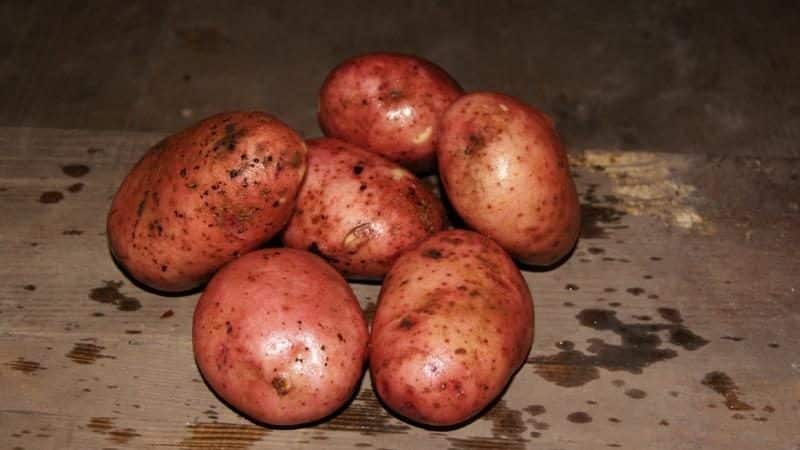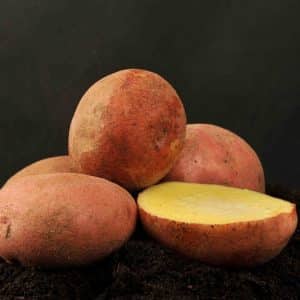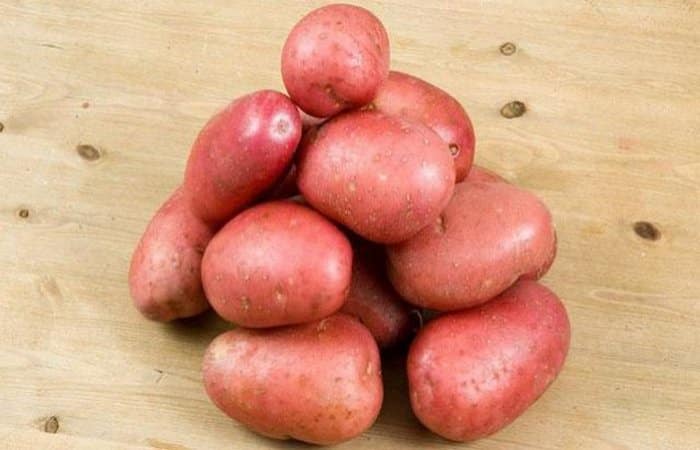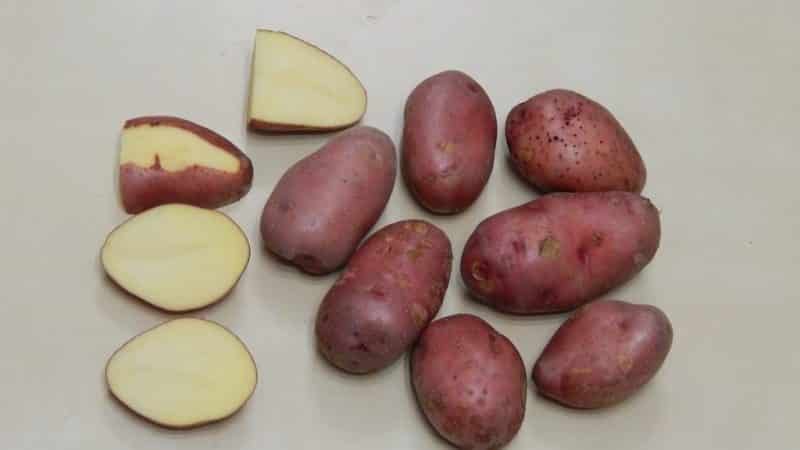High-yielding, frost-resistant potato variety “Zhuravinka” with excellent taste
The Zhuravinka potato was bred in Belarus and is not much inferior to its Dutch counterparts. All characteristics of the variety meet international standards. Many summer residents love it for its high yield, excellent taste and good keeping quality.
Description of the variety, origin and development
Zhuravinka is a mid-late variety of table potatoes.
Russian and Belarusian breeders worked on developing the variety. In 2005, the variety was included in the State Register of Russia. The patent was issued by the Belarusian Republican Unitary Enterprise NPC NAS.

Chemical composition, trace elements and vitamins
The energy value of potatoes per 100 g is 73 kcal.
Nutritional value per 100 g:
- water – 80 g;
- proteins – 1.9 g;
- fats – 0.1 g;

- carbohydrates – 16.6 g;
Potatoes contain 19% starch.
Chemical composition per 100 g:
- vitamin B1 – 0.08 mg;
- vitamin B2 – 0.03 mg;
- vitamin B3 – 1.1 mg;
- vitamin B6 – 0.24 mg;
- vitamin B9 – 16.5 mcg;
- vitamin C – 11 mg;
- calcium – 11 mg;
- magnesium – 22 mg;
- phosphorus – 59 mg;
- potassium – 426 mg;
- lutein – 13 mcg;
Tubers contain amino acids and saturated fatty acids. The vegetable contains small amounts of monounsaturated and polyunsaturated fatty acids.
Ripening time and yield
Zhuravinka potatoes ripen 100-110 days after emergence. In warm regions, the vegetable may ripen in 90 days.
From 1 hectare they get 500-600 centners of potatoes, sometimes the figure reaches 700 centners.
Reference. 15-20 medium and large tubers are dug from one bush.
Gardeners who own small plots harvest 7-8 kg of potatoes from 1 m² of plantings.
Disease resistance
The variety has strong immunity to golden nematode And potato crayfish. Resistant to scab, blackleg and late blight of tubers. But Zhuravinka’s resistance to rhizoctonia and late blight of the ground part is low.
Characteristics of tubers, description of appearance

Features of tubers:
- oval-round or rounded shape;
- the surface of the tuber is smooth or embossed, covered with a kind of mesh;
- the peel is reddish, the flesh is light yellow;
- the eyes are small, evenly distributed over the surface;
- weight 120-180 g, but there are large specimens up to 300 g;
Potato bushes up to 50 cm high. Stems 0.6-1 cm thick. Leaves are round, dark green, the central vein is darker, the edges are wavy.
The inflorescences are small in size and consist of 6-7 flowers of a reddish-violet or violet hue. Berries appear rarely.
Region for cultivation
The variety is recommended for cultivation in the North-Western, Central and Volga-Vyatka regions. Summer residents also cultivate it in other regions - from the Vologda region to the Perm region.
The main advantages and disadvantages of the variety
The crane has many advantages:
- excellent taste;
- quick cooking;
- high keeping quality;
- resistance to many potato diseases;
- good transportability;
- frost resistance;
- stable and high yield.
Minuses:
- long ripening of tubers;
- sensitivity to lack of moisture.
Features of planting and growing
At landing and when growing, it is important to take into account the nuances in order to achieve maximum yield.
Preparing for landing
To obtain friendly shoots, potato tubers are prepared in advance for planting:
- Germination. 4 weeks before planting, the tubers are sorted and placed in a bright, warm room with a temperature of +13...+15°C.
- Landscaping. In order for solanine to form in the seed tubers, they are kept in the sun for a week.
- Treatment with disinfectants. Before planting, the planting material is sprayed with the preparations “Fitosporin”, “Maxim”, “Prestige” in order to protect the plants from wireworm attacks, Colorado potato beetle and other pests.
After this, they begin to prepare the beds and plant potatoes.
Soil requirements
For planting, choose a sunny area where the groundwater is shallow.
Attention. After eggplants, peppers and tomatoes, potatoes are not planted on the plot for at least 3 years.
It is not recommended to plant the crop in dry and hard soil - this will affect germination. And planting in too wet soil will lead to complete loss of seedlings. The soil should be loose and nutritious.
Dates, scheme and rules of planting
The crane is planted when the air temperature rises to +16...+18°C, and the soil is warmed up to +10..+12°C.
In the northern regions, planting is carried out in the first ten days of May. In the central regions - at the end of April or beginning of May. And in the southern region - in mid-April.
Plant potatoes like this:
- Dig holes 15-20 cm deep. The planting pattern is standard. The distance between rows is 70 cm, and between bushes 30 cm.
- A handful of onion peels and wood ash are added to each hole.
- The seeds are planted with the sprouts facing up.
- The holes are sprinkled with earth so that air flows to the roots.
The depth of seed placement depends on the soil: for light soil - 10 cm, and for clay soil - 7 cm.
The crane emerges together and immediately begins to grow intensively.
Recommendations for cultivation
During the growth and development of the vegetable, follow the recommendations:
- The variety has a negative attitude towards excess nitrogen fertilizers. Therefore, it is better to underfeed him than to overfeed him.
- It is important to maintain the required distance between potato bushes, since each plant produces many tubers and they need enough space for full development.
- During the period of growth and flowering, plantings need additional moisture. But at the same time, the Crane does not tolerate waterlogging and begins to get sick if there is too much water. In rainy summers, carry out preventive treatment of bushes with Fundazol.
In general, potatoes respond well to the addition of mineral and organic additives. The variety is frost-resistant: if frost occurs after planting, the plants will not die.
Nuances of care
To form more large tubers, the variety needs proper care.
Watering mode
Zhuravinka potatoes do not like prolonged drought. Therefore, in the absence of rain, plantings need watering. The amount of irrigation depends on the condition of the soil and the presence of precipitation.
During the period of intensive growth, it is recommended to water the beds weekly. But do not over-moisten - in damp soil there is a high risk of late blight.
Watering is carried out in the evening or morning hours. Water calculation: 4-5 liters for each bush.
Top dressing
Feed culture is recommended according to the following scheme:
- Before flowering. 1 tbsp. l. urea is diluted in 10 liters of water. Apply 500 ml of solution under each bush.
- During the formation of buds. 1 tbsp. l. Mix “superphosphate” and a glass of ash with 10 liters of water. For one bush – 500 ml.
- During flowering. 1 tbsp. l. “Superphosphate” per 10 liters of water. Consumption per plant – 500 ml.
Strictly follow the recommended dosages to avoid excess nitrogen. Otherwise, the potatoes will stop growing and new tubers will not form.
Weeding and hilling
When shoots appear, the soil is loosened, removing weeds, for better penetration of water and air to the roots. Then loosening is repeated as necessary so that a crust does not form.
When the bushes grow 15-20 cm high, they are hilled. To do this, a small hill is made in the area around the trunk.
Important! In the northern regions, the soil is loosened 5-6 times during the growing season.
The second hilling is carried out after 20 days. This time usually corresponds to the flowering phase. The procedure is needed to prevent root disease, loosen the soil and destroy weeds.
Disease and pest control
The variety is resistant to many potato diseases. However, a humid environment often causes the development of late blight. At the first signs of the disease - spots on the leaves, the plantings are treated with copper-containing preparations - Bordeaux mixture, copper oxychloride.
Among the pests, the Colorado potato beetle and wireworm are the most dangerous. But if other varieties of potatoes grow on the site, then the beetle does not land on Zhuravinka.
Attention. Treatment of plants against pests with chemicals is carried out no less than 30 days before harvesting the tubers.
The fight against the Colorado potato beetle is carried out by collecting it manually or using store-bought insecticides.
Harvest and storage

You can start digging up the vegetable a little earlier. But to store, wait until the tubers are completely ripe.
How and when to collect
Potatoes are harvested when the tops begin to dry out and turn yellow. Potatoes are dug up with a pitchfork or shovel.This is done carefully so as not to damage the tubers.
Storage features and keeping quality of the variety
The collected potatoes are dried for several hours in the beds, then sorted. Tubers selected for long-term storage are once again laid out to dry in a warm place out of direct sunlight.
After this, the vegetables can be stored in a well-dried basement or cellar. The temperature there should be +3..+4°C. The keeping quality of the variety is 96%.
Difficulties in growing
When caring for Zhuravinka potatoes, some problems may arise:
- the variety does not tolerate waterlogged soil, but drought also negatively affects the harvest;
- Fertilizers must be applied correctly to prevent excess nitrogen;
It is worth checking the plantings periodically for the presence of Colorado potato beetles, otherwise the entire crop may die.
Advice from experienced gardeners and reviews about the Zhuravinka variety
Many summer residents advise digging up the area in the fall and adding a bucket of rotted manure, 10 g of “Superphosphate” and a glass of wood ash - the dosage per 1 m² of area. In spring, the land is plowed again, but without fertilizers.
To combat Colorado potato beetles, fragrant plants are planted next to potato bushes.
Reviews about the Zhuravinka variety are mostly good. Many people like the taste and abundant harvest. However, summer residents note that potatoes require care. Gardeners sometimes call this potato variety Zhuravushka.
Vasily, Perm: «I planted this variety on my plot and began to notice that it was rather difficult to care for. In order for the bushes to grow well, it was necessary to fertilize with minerals and organic matter several times. However, it tastes good.”
Natalya, Moscow: “I want to note the excellent taste of Zhuravushka potatoes. Children adore her.The puree is prepared without unnecessary manipulations, it turns out without lumps and has the perfect color.”
Lida, Barnaul: “The variety turned out to be very productive. I came across him by accident. I read a description of the Zhuravinka potato variety on the Internet and saw a photo of the harvest. Compared to other varieties, Zhuravinka has the most tubers per bush.”
Conclusion
Thanks to the abundant harvest and immunity to disease, Zhuravinka potatoes have become popular not only in Russia, but also in neighboring countries. The sprouts on the tubers are strong and sprout quickly. Many gardeners note that even during frosts, the percentage of yield is maintained.